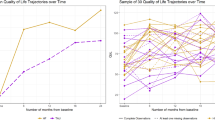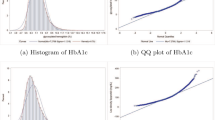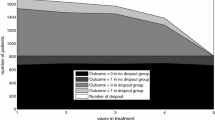Abstract
Experiments involving repeated observations of multivariate outcomes are common in biomedical and public health researches which lead to multivariate longitudinal data. These kinds of data have a unique property in the sense that they allow the researcher to study the joint evolution of the multiple outcomes over the time. Recently, there has been a considerable amount of interest on using Bayesian modelling of longitudinal data, data which commonly suffer from incomplete observations. Those Bayesian models for longitudinal data that rely on the ignorability assumption of the dropout mechanism might give misleading inferences. Hence, there is a need to further study the impact of departures from the ignorability assumption on the Bayesian estimates of the model parameters. Current methodology for Bayesian sensitivity analysis mostly involves single response variable in both cross-sectional and longitudinal studies. In this paper, we propose a multivariate extension of the Bayesian index of sensitivity to non-ignorability for the general case of multivariate longitudinal studies with the possibility of having mixed correlated outcomes and a vector of multiple non-ignorability parameters in the missing mechanism. To simultaneously model the mixed responses over the time, we use a random effect latent variable approach. We illustrate the method conducting some simulation studies and analyzing a real data set from a longitudinal study for the comparison of two oral treatments for toenail dermatophyte onychomycosis.



Similar content being viewed by others
References
Chib, S., Greenberg, E.: Understanding the Metropolis–Hastings algorithm. Am. Stat. 49, 327–335 (1995)
Copas, J.B., Eguchi, S.: Local sensitivity approximations for selectivity bias. J. R. Stat. Soc. Ser. B 63, 871–895 (2001)
Copas, J.B., Li, H.G.: Inference for non-random samples (with discussion). J. R. Stat. Soc. Ser. B 59, 55–95 (1997)
De Backer, M., De Keyser, P., De Vroey, C., Lesaffre, E.: A 12-week treatment for dermatophyte toe onychomycosis: terbinafine 250 mg/day vs. itraconazole 200 mg/daya double-blind comparative trial. Br. J. Dermatol. 134, 16–17 (1996)
Diggle, P., Kenward, M.G.: Informative drop-out in longitudinal data analysis (with discussion). Appl. Stat. 43, 49–73 (1994)
Eftekhari Mahabadi, S., Ganjali, M.: An index of local sensitivity to non-ignorability for multivariate longitudinal mixed data with potential non-random dropout. Stat. Med. 29(17), 1779–1792 (2010)
Gilks, W.R., Wild, P.: Adaptive rejection sampling for Gibbs sampling. Appl. Stat. 41, 337–348 (1992)
Hastings, W.K.: Monte Carlo sampling method using Markov chains and their applications. Biometrika 57, 97–109 (1970)
Heckman, J.J.: Dummy endogenous variable in a simultaneous equation system. Econometrica 46(6), 31–959 (1978)
Little, R.J.A.: Modeling the dropout mechanism in repeated-measures studies. J. Am. Stat. Assoc. 90, 1112–1121 (1995)
Little, R.J.A., Rubin, D.B.: Statistical Analysis with Missing Data, 2nd edn. Wiley, New York (2002)
Ma, G., Troxel, A.B., Heitjan, D.F.: An index of local sensitivity to nonignorable dropout in longitudinal modeling. Stat. Med. 24, 2129–2150 (2005)
Metropolis, N., Rosenbluth, A.W., Rosenbluth, M.N., Teller, A.H., Teller, E.: Equations of state calculations by fast computing machines. J. Chem. Phys. 21, 1087–1091 (1953)
Molenberghs, G., Kenward, M.G.: Missing Data in Clinical Studies. Wiley, Chichester (2007)
Molenberghs, G., Verbeke, G.: Models for Discrete Longitudinal Data. Springer, New York (2005)
Qian, Y., Xie, H.: Measuring the impact of nonignorability in panel data with non-monotone nonresponse. J. Appl. Econom. 27(1), 129–159 (2010)
Ripley, B.: Stochastic Simulation. Wiley, New York (1987)
Roberts, D.T.: Prevalence of dermatophyte onychomycosis in the United Kingdom: results of an omnibus survey. Br. J. Dermatol. 126(Suppl. 39), 23–27 (1992)
Rubin, D.B.: Inference and missing data. Biometrika 63, 581–592 (1976)
Scharfstein, D., Rotnitzky, A., Robins, J.M.: Adjusting for nonignorable dropout using semiparametric models (with discussion). J. Am. Stat. Assoc. 94, 1096–1146 (1999)
Troxel, A.B., Ma, G., Heitjan, D.F.: An index of local sensitivity to nonignorability. Stat. Sin. 14, 1221–1237 (2004)
Vach, W., Blettner, M.: Logistic regression with incompletely observed categorical covariates investigating the sensitivity against violation of the missing at random assumption. Stat. Med. 14, 1315–1329 (1995)
Verbeke, G., Lesaffre, E., Spiessens, B.: The practical use of different strategies to handle dropout in longitudinal studies. Drug Inf. J. 35, 419–434 (2001)
Verbeke, G., Molenberghs, G.: Linear Mixed Models for Longitudinal Data. Springer, New York (2000)
Xie, H.: A local sensitivity analysis approach to longitudinal non-Gaussian data with non-ignorable dropout. Stat. Med. 27, 3155–3177 (2008)
Xie, H.: Bayesian inference from incomplete longitudinal data: a simple method to quantify sensitivity to nonignorable dropout. Stat. Med. 28, 2725–2747 (2009)
Xie, H., Heitjan, D.F.: Sensitivity analysis of causal inference in a clinical trial subject to crossover. Clin. Trials 1, 21–30 (2004)
Xie, H., Heitjan, D.F.: Local sensitivity to nonignorability: dependence on the assumed dropout mechanism. Stat. Biopharm. Res. 1, 243–257 (2009)
Zhang, J., Heitjan, D.F.: A simple local sensitivity analysis tool for nonignorable coarsening: application to dependent censoring. Biometrics 62, 1260–1268 (2006)
Zhang, J., Heitjan, D.F.: Impact of nonignorable coarsening on Bayesian inference. Biostatistics 8, 722–743 (2007)
Author information
Authors and Affiliations
Corresponding author
Appendix: Bayesian ISNI derivation
Appendix: Bayesian ISNI derivation
Assume that there is a \(s=(m+n)\) dimensional vector of non-ignorability parameters \(\Gamma _1=(\gamma _{11},\ldots , \gamma _{1s})\) in the missing mechanism and that \(\eta =(\Theta , \Gamma _0)\) is the vector of model parameters. We define the Bayesian ISNI in the case of multiple non-ignorability parameters as the partial first derivatives of the posterior mean of \(\eta \) with respect to \(\Gamma _1\), i.e.,
where the elements of the above vector could be calculated as follows:
where \(E_I(.)\) and \(COV_I(.)\) denote the posterior mean and covariance functions for the ignorable model. Hence the vector of Bayesian sensitivity index could be denoted as:
Now if we want to calculate the Bayesian ISNI for the multivariate mixed longitudinal model of Sect. 2, we have to compute the first order derivations of the corresponding log likelihood function (logarithm of the quantity in Eq. (4)).
Assume that \(y_{i}^{obs}=(y_{i1},\ldots ,y_{iM_i})\), \(z_{i}^{obs}=(z_{i1},\ldots ,z_{iM_i})\), where for \(t=1,\ldots , M_i\), \(y_{it}=\{y_{ijt}: 1\le j \le m\}\) and \(z_{it}=\{z_{ikt}: 1\le k \le n \}\), and also assume that the non-ignorability parameters in Eq. (3) are denoted by, \(\Gamma _1=(\Gamma _{11}, \Gamma _{12})\), where \(\Gamma _{11}=(\xi _{1},\ldots ,\xi _{m})\) and \(\Gamma _{12}=(\eta _{1},\ldots ,\eta _{n})\). The log likelihood function for the multivariate mixed longitudinal model of Sect. 2 could be decomposed as the sum of the following three terms;
According to the above decomposition, \(\frac{\partial l_1}{\Gamma _1^T}=0\) since \(l_1\) is not a function of \(\Gamma _1\). Also the derivatives of \(l_2\) and \(l_3\) are as follows;
where,
and \(g_{i,M_i+1}=P(R_{i,M_i+1}=1|W_{i,M_i+1},W_{i,M_i},X,R_{i,M_i}=1)\) which has been modeled in Eq. (3). Also, the posterior means are calculated with respect to the posterior distribution of \(B_i\) given \(W_i^{obs}=(y_{i}^{obs}, z_{i}^{obs})\) for the ignorable model (i.e., \(\phi (B_i|W_{i,M_i})\)).
According to Eq. (15), we need the posterior covariance of the above quantities with the vector of parameters \(\eta \) where we have, \(COV_{I}(\eta ,\frac{\partial l_2}{\partial \Gamma _1^T}\vert _{\Gamma _1=0})=0\). Hence, the vector of Bayesian ISNI with multiple non-ignorability parameters for the multivariate longitudinal data would be reduced to:
On the other hand, one can approximate the above vector of covariances using the Delta method which leads to the following approximation:
where \(VAR_I(\eta )\) is the covariance matrix of the posterior distribution of \(\eta \) evaluated at the ignorable model.
Rights and permissions
About this article
Cite this article
Mahabadi, S.E., Ganjali, M. A Bayesian approach for sensitivity analysis of incomplete multivariate longitudinal data with potential nonrandom dropout. METRON 73, 397–417 (2015). https://doi.org/10.1007/s40300-015-0063-6
Received:
Accepted:
Published:
Issue Date:
DOI: https://doi.org/10.1007/s40300-015-0063-6




